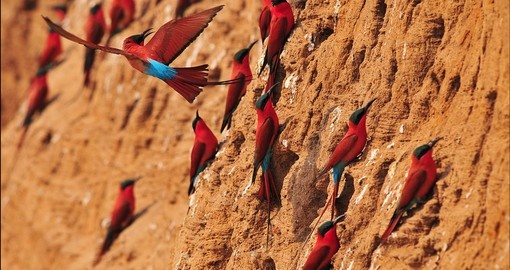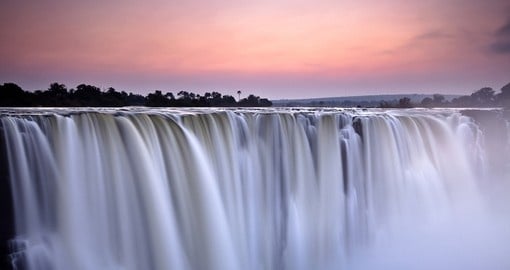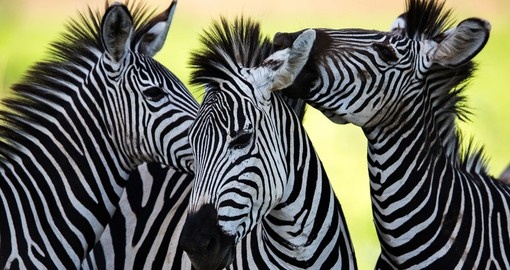Zambia Nature and Wildlife
Nature
Nature conservation is very important to the government of Zambia as wildlife and ecotourism are staples of the economy. Despite a commitment to nature preservation, the country is faced with many obstacles. There are two seasons in Zambia, one of abundance and one of stress. The abundance season is the rainy season and as such, nature grows and thrives. However, during the rest of the year, river channels are significantly reduced and the land becomes dry. Food sources become scarce for both humans and animals alike. Rural populations are then forced to hunt and poach for meat to either eat or sell. The country greatly lacks alternative food and income sources.
In response to this problem, the government and conservation groups like the Wildlife Conservation Society (WCS) are working to find the balance between human and wildlife needs. One such initiative, Poachers-turned-Protectors has WCS and Community Markets for Conservation (COMACO) working together to find sustainable sources of alternative income. This project encourages people to turn in their illegal snares and guns in return for training in skills like farming and carpentry. More than 50,000 snares and 1,700 firearms have been voluntarily brought in.
With nineteen national parks and thirty-four game management areas, 23 million ha, or 30% of Zambia has been devoted to conservation. Each park is unique and offers stunning views of African wildlife, however, two of the most popular areas to visit are Kafue National Park and Mosi-oa-Tunya. Kafue National Park is Zambia’s oldest and largest park as well as one of the largest parks in Africa. The Kafue River which is home to otters, water monitors, hippos and crocodiles, divides the country from north and south. Lions, leopards and cheetahs are frequently spotted. The park hosts the Itezhi Tezhi Dam which houses elephant populations as well as buffaloes, zebras and wildebeest.
Perhaps the most famous and popular national park in Zambia is Mosi-oa-Tunya (“the Smoke that Thunders”, also known as Victoria Falls. Zambia shares this incredible UNESCO World Heritage Site with Zimbabwe. During the rainy season, Victoria Falls forms the largest sheet of falling water in the world. There is a wildlife park located near the falls that house five introduced white rhinos. Elephants cross during the dry season and vervet monkeys and baboons are commonly spotted.
Wildlife
Zambia offers one of Africa’s finest safari destinations, showcasing classic African animals. Elephants are found in certain national parks including South Luangwa and the Lower Zambezi National Park. Those parks are also excellent places to spot Zambia’s native giraffe subspecies, Thornicroft’s giraffe. The grasslands of Zambia are home to herds of zebras, impalas, wildebeest (the Cookson wildebeest is endemic) and various antelope species including pukus, the endemic Kafue lechwe, bushback, eland, impalas and many more.
The annual wildebeest migration in Zambia is second only to the Serengeti migration in Tanzania. With such a large population of grazing animals, it is not surprising that various predators are also found in Zambia. Such predators include lions, leopards and hyenas and the elusive cheetah. Riverbeds are good places to spot hippopotamus and Nile crocodiles.
Zambia has a diverse birdlife culture, boasting over 740 recorded species. Many rare birds call Zambia home. The Shoebill stork is one of Africa’s rarest birds, found in very few places on the continent, Zambia is one of them. More than half of the world’s Wattled Crane population (the largest crane in Africa and the second largest crane in the world) inhabit the wetlands of Zambia.
Many lizards exist throughout the country with geckos and chameleons being the most common. The water monitor is often spotted lying around waterholes. Zambia’s most notable reptile is the Nile crocodile. Despite decreasing numbers due to habitat destruction and hunting, crocodiles are still widespread in Zambia and are often spotted in national parks like South Luangwa, Kafue and Lower Zambezi. Zambia also hosts a mixture of harmless and venomous snakes, the largest being the Python which grows over 5 m in length.
Zambia Travel Information
At Goway we believe that a well-informed traveller is a safer traveller. With this in mind, we have compiled an easy-to-navigate travel information section dedicated to Zambia.
Learn about the history and culture of Zambia, the must-try food and drink, and what to pack in your suitcase. Read about Zambia's nature and wildlife, weather and geography, along with 'Country Quickfacts' compiled by our travel experts. Our globetrotting tips, as well as our visa and health information, will help ensure you're properly prepared for a safe and enjoyable trip. The only way you could possibly learn more is by embarking on your journey and discovering Zambia for yourself. Start exploring… book one of our Zambia tours & safaris today!
Extend Your Trip
After your Africa tours, why not consider one of Goway's Europe tours or Egypt tours en route from Zambia or perhaps a stopover in Dubai on one of our United Arab Emirates tours
Book your Zambia tour with Goway!
 AfricaExperts is the exclusive division of Goway that specializes in planning and organizing Zambia tours and experiences. Choose from a simple city stopover, an exclusive African safari, a stay of distinction, a small group tour, an independent travel module and more. We want to be your first choice when next you go globetrotting to Zambia.
AfricaExperts is the exclusive division of Goway that specializes in planning and organizing Zambia tours and experiences. Choose from a simple city stopover, an exclusive African safari, a stay of distinction, a small group tour, an independent travel module and more. We want to be your first choice when next you go globetrotting to Zambia.
Get a Trip Quote Order a Brochure



















